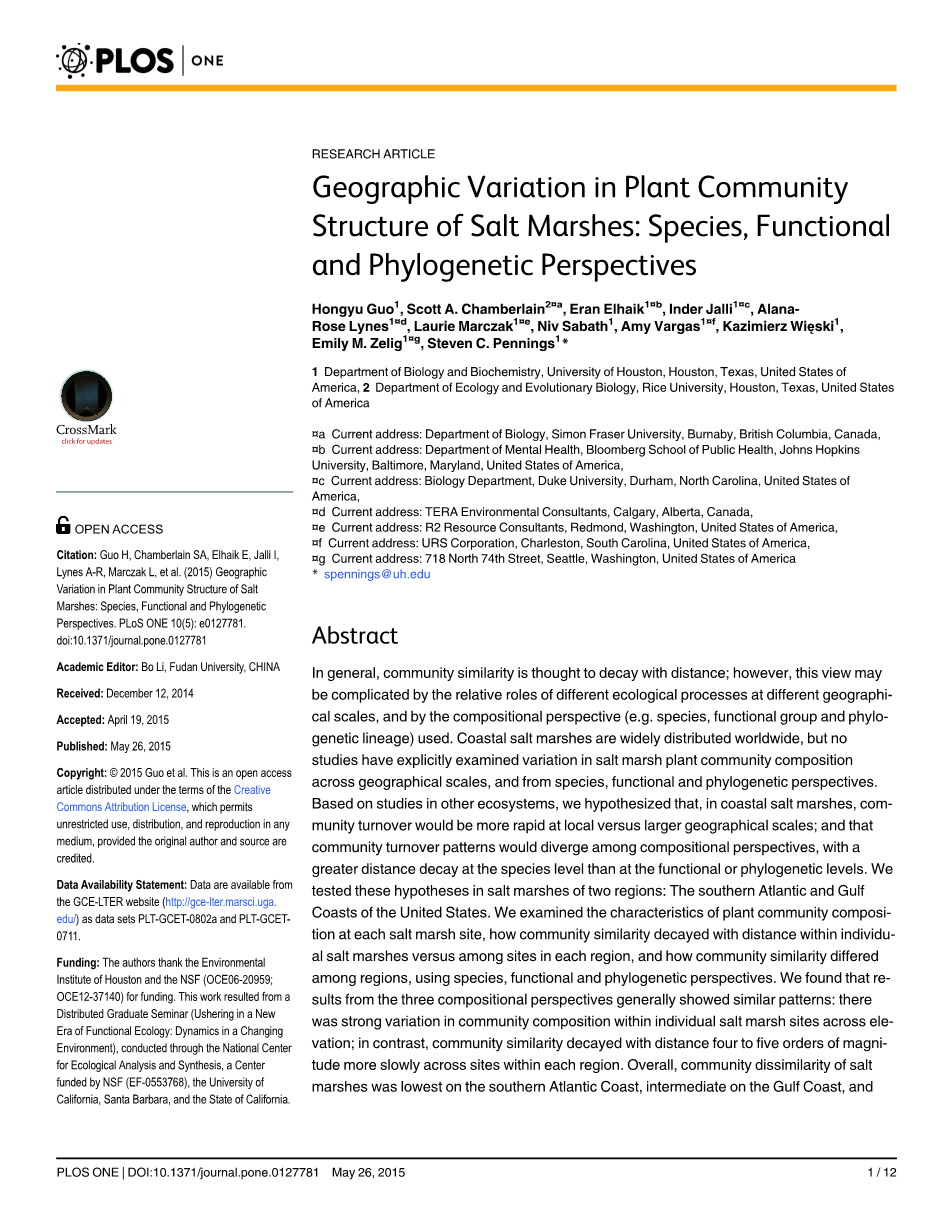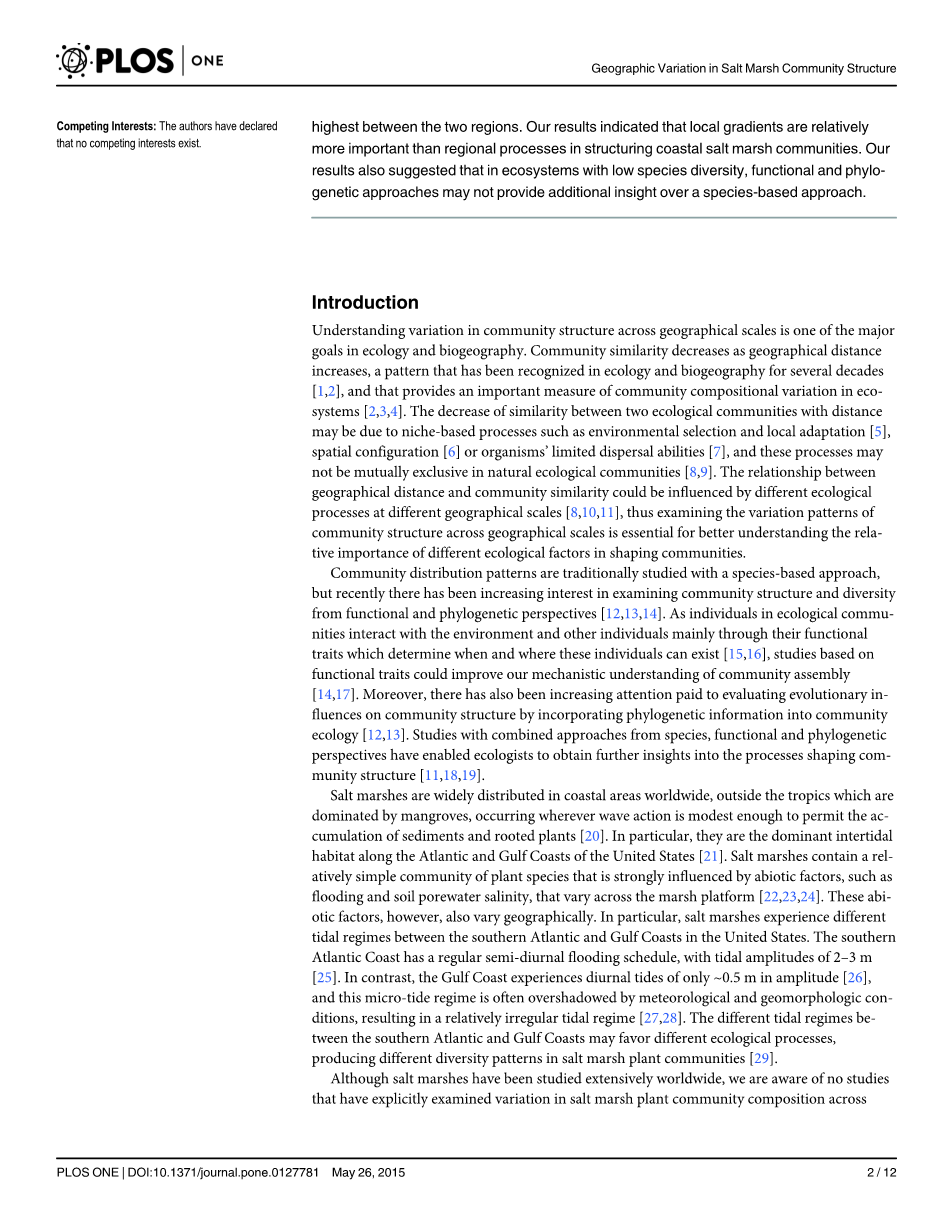景宁望东垟中山湿地群落种群特征分析外文翻译资料
2023-01-03 12:26:32
OPEN ACCESS
Citation: Guo H, Chamberlain SA, Elhaik E, Jalli I, Lynes A-R, Marczak L, et al. (2015) Geographic Variation in Plant Community Structure of Salt Marshes: Species, Functional and Phylogenetic Perspectives. PLoS ONE 10(5): e0127781. doi:10.1371/journal.pone.0127781
Academic Editor: Bo Li, Fudan University, CHINA Received: December 12, 2014 Accepted: April 19, 2015 Published: May 26, 2015
Copyright: copy; 2015 Guo et al. This is an open access article distributed under the terms of the Creative Commons Attribution License, which permits unrestricted use, distribution, and reproduction in any medium, provided the original author and source are credited.
Data Availability Statement: Data are available from the GCE-LTER website (http://gce-lter.marsci.uga. edu/) as data sets PLT-GCET-0802a and PLT-GCET- 0711.
Funding: The authors thank the Environmental Institute of Houston and the NSF (OCE06-20959; OCE12-37140) for funding. This work resulted from a Distributed Graduate Seminar (Ushering in a New Era of Functional Ecology: Dynamics in a Changing Environment), conducted through the National Center for Ecological Analysis and Synthesis, a Center funded by NSF (EF‐0553768), the University of California, Santa Barbara, and the State of California.
RESEARCH ARTICLE
Geographic Variation in Plant Community Structure of Salt Marshes: Species, Functional and Phylogenetic Perspectives
Hongyu Guo1, Scott A. Chamberlain2curren;a, Eran Elhaik1curren;b, Inder Jalli1curren;c, Alana- Rose Lynes1curren;d, Laurie Marczak1curren;e, Niv Sabath1, Amy Vargas1curren;f, Kazimierz Więski1, Emily M. Zelig1curren;g, Steven C. Pennings1*
1 Department of Biology and Biochemistry, University of Houston, Houston, Texas, United States of America, 2 Department of Ecology and Evolutionary Biology, Rice University, Houston, Texas, United States of America
curren;a Current address: Department of Biology, Simon Fraser University, Burnaby, British Columbia, Canada,
curren;b Current address: Department of Mental Health, Bloomberg School of Public Health, Johns Hopkins University, Baltimore, Maryland, United States of America,
curren;c Current address: Biology Department, Duke University, Durham, North Carolina, United States of America,
curren;d Current address: TERA Environmental Consultants, Calgary, Alberta, Canada,
curren;e Current address: R2 Resource Consultants, Redmond, Washington, United States of America,
curren;f Current address: URS Corporation, Charleston, South Carolina, United States of America,
curren;g Current address: 718 North 74th Street, Seattle, Washington, United States of America
Abstract
In general, community similarity is thought to decay with distance; however, this view may be complicated by the relative roles of different ecological processes at different geographi- cal scales, and by the compositional perspective (e.g. species, functional group and phylo- genetic lineage) used. Coastal salt marshes are widely distributed worldwide, but no studies have explicitly examined variation in salt marsh plant community composition across geographical scales, and from species, functional and phylogenetic perspectives. Based on studies in other ecosystems, we hypothesized that, in coastal salt marshes, com- munity turnover would be more rapid at local versus larger geographical scales; and that community turnover patterns would diverge among compositional perspectives, with a greater distance decay at the species level than at the functional or phylogenetic levels. We tested these hypotheses in salt marshes of two regions: The southern Atlantic and Gulf Coasts of the United States. We examined the characteristics of plant community composi- tion at each salt marsh site, how community similarity decayed with distance within individu- al salt marshes versus among sites in each region, and how community similarity differed among regions, using species, functional and phylogenetic perspectives. We found that re- sults from the three compositional perspectives generally showed similar patterns: there was strong variation in community composition within individual salt marsh sites across ele- vation; in contrast, community similarity decayed with distance four to five orders of magni- tude more slowly across sites within each region. Overall, community dissimilarity of salt marshes was lowest on the southern Atlantic Coast, intermediate on the Gulf Coast, and
Competing Interests: The authors have declared that no competing interests exist.
highest between the two regions. Our results indicated that local gradients are relatively more important than regional processes in structuring coastal salt marsh communities. Our results also suggested that in ecosystems with low species diversity, functional and phylo- genetic approaches may not provide additional insight over a species-based approach.
Introduction
Understanding variation in community structure across geographical scales is one of the major goals in ecology and biogeography. Community similarity decreases as geographical distance increases, a pattern that has been recognized in ecology and biogeography for several decades [1,2], and that provides an important measure of community compositional variation in eco-
剩余内容已隐藏,支付完成后下载完整资料


英语原文共 12 页,剩余内容已隐藏,支付完成后下载完整资料
资料编号:[281999],资料为PDF文档或Word文档,PDF文档可免费转换为Word




